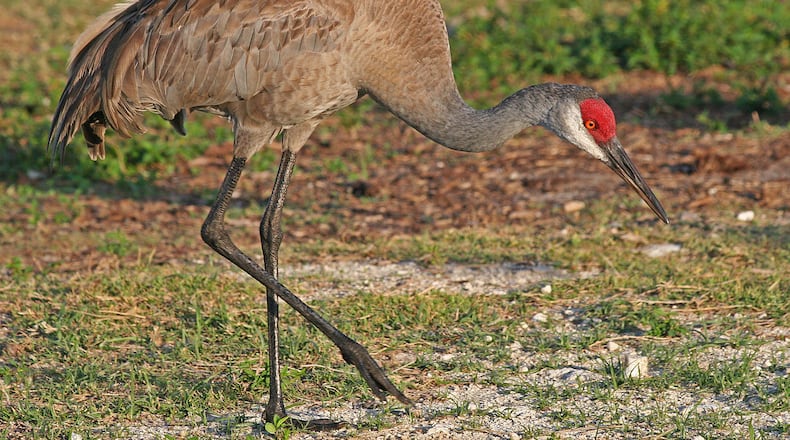Be alert now for one of nature’s grandest events during November and December — the southbound migration of greater sandhilll cranes. Flying high in loose, undulating V-formations during the day, the big birds are starting to move through Georgia on their way to winter grounds in Florida and Georgia’s Okefenokee Swamp.
Few natural spectacles in the state generate as much thrill as large flocks of sandhill cranes flying high overhead — all the while uttering their loud, resonant, bugling calls that sound something like gu-rrroo, gu-rrroo, gu-rrroo. So loud are the birds that they can be heard — like a huge flock of chirping birds — up to 2½ miles away.
A single sandhill flock may consist of as many as 300 birds; and wave after wave of them may fly by within a short time. At night, most flocks settle down to rest and refuel in smaller wetlands along their route.
The birds that pass through Georgia are a subspecies dubbed greater sandhill cranes. The adults — grayish with prominent, bright-red crowns — stand nearly four feet tall and have a wingspan of more than six feet. They breed during spring and summer in the Great Lakes region and in southern Canada.
In Georgia, their migration route follows a corridor roughly centered on I-75. Their fall destinations are winter grounds in Central Florida and, to a lesser extent, the Okefenokee Swamp and other wetlands in southeastern Georgia. (A small, nonmigratory group of sandhills also lives year-round in the Okefenokee.)
Come February, the birds will use the same route to return to their breeding grounds up north. Many people confuse migrating sandhill cranes with Canada geese. But sandhills usually fly much higher than geese, and the cranes’ trumpeting sounds are distinctively different from the geese’s honking. Also, sandhill cranes’ long, thin legs trail behind them in flight, and they have longer, thinner necks than geese.
IN THE SKY: From David Dundee, Tellus Science Museum astronomer: The annual Leonid meteor shower will peak tonight at about 20 meteors per hour in the northeast after dark. The moon is full this weekend — the beaver moon, also known as the trading moon. Mercury and Venus are low in the west around dusk. Mars rises in the east at about midnight. Jupiter rises in the east, and Saturn is in the south just after dark.
Charles Seabrook can be reached at charles.seabrook@yahoo.com.
About the Author
Keep Reading
The Latest
Featured

